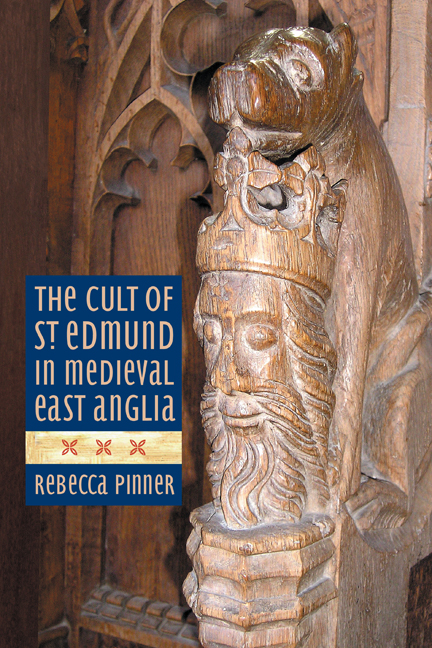Book contents
- Frontmatter
- Contents
- List of Illustrations
- Acknowledgements
- Abbreviations
- Introduction
- Part I Texts and Contexts: the Legend of St Edmund
- Part II Relics, Shrines and Pilgrimage: Encountering St Edmund at Bury
- Part III Beyond Bury: Dissemination and Appropriation
- Conclusion: ‘Martir, Mayde and Kynge’, and More
- Appendix 1 Synoptic Account of the Legend of St Edmund
- Appendix 2 Chronology of Significant Events and Texts Associated with the Cult of St Edmund
- Bibliography
- Index
- Frontmatter
- Contents
- List of Illustrations
- Acknowledgements
- Abbreviations
- Introduction
- Part I Texts and Contexts: the Legend of St Edmund
- Part II Relics, Shrines and Pilgrimage: Encountering St Edmund at Bury
- Part III Beyond Bury: Dissemination and Appropriation
- Conclusion: ‘Martir, Mayde and Kynge’, and More
- Appendix 1 Synoptic Account of the Legend of St Edmund
- Appendix 2 Chronology of Significant Events and Texts Associated with the Cult of St Edmund
- Bibliography
- Index
Summary
‘To us too had the last day, the inevitable moment, come: we were monks, the glory and honour of Eastern England were, but the fierce fire is seizing it all, and mastering the holy temple.’
IN November 1535 Thomas Cromwell's Commissioners arrived at the abbey of Bury St Edmunds to report on the condition of the monastery and the extent of its wealth. Three years later they returned to confiscate the abbey's possessions for the Crown, writing to Cromwell of their successes:
Pleasith it your lordship to be advertised that wee have ben at saynt Edmondes Bury, where we found a riche shryne which was very comberous to deface. We have takyn in the seyd monastery in golde and sylver MMMMM markes, and above, over and besides a well and riche crosse with emereddes, as also dyvers and sundry stones of great value … and we assure your lordship that the abbott and convent be very well contented with every thing that we have done there.
In September 1539 the abbey was dissolved. The ‘riche shryne’ belonged to St Edmund, erstwhile king of Norfolk and Suffolk, who met his death at the hands of the Great Viking Army on 20 November 869. The value of the goods seized by the Commissioners attests to the wealth and prestige accrued by the abbey, ‘the glory and honour of Eastern England’ referred to above by the monastic chronicler, due largely to the reputation and popularity of their saintly patron. More than sixty medieval churches throughout the country bore his dedication, many of which were also adorned with his image. Between the tenth and sixteenth centuries more than thirty separate accounts of his legend were written in Latin, Old English, Anglo-Norman, Old French or Middle English. For much of the Middle Ages Bury was one of the most popular pilgrimage destinations in England and Edmund's cult also enjoyed some popularity abroad, particularly in Scandinavia and Iceland, at Saint-Denis near Paris, at Lucca in Italy (from the tenth to the twelfth century) and at Toulouse in the south of France (from the thirteenth century).
Edmund was an enduring favourite with the English monarchy.
- Type
- Chapter
- Information
- The Cult of St Edmund in Medieval East Anglia , pp. 1 - 30Publisher: Boydell & BrewerPrint publication year: 2015



